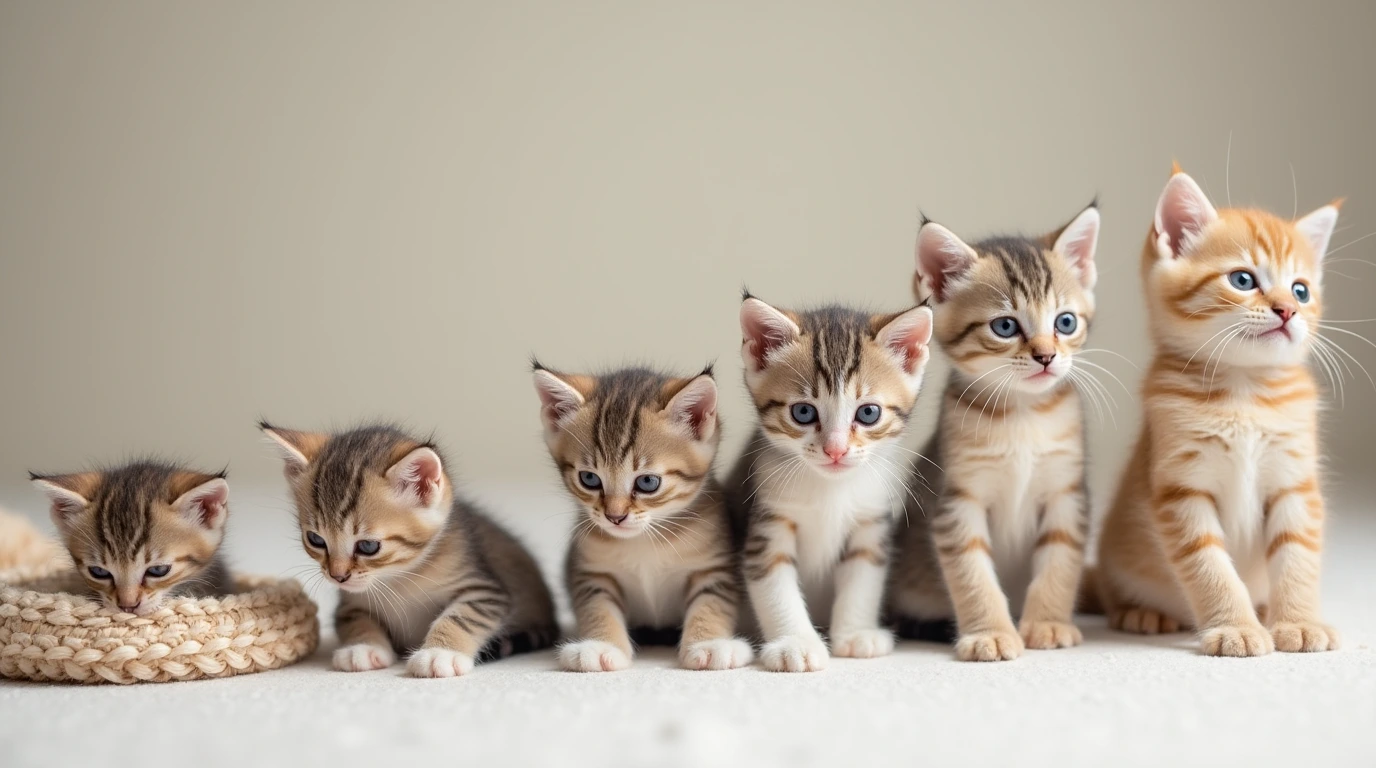All About Kitten Stages
Watching your kitten grow from a tiny, curious bundle into a graceful, confident cat is a journey filled with discovery and joy. As you navigate each stage of your kitten’s development, understanding the unique changes and needs that come with each phase is crucial for helping your pet grow up healthy, happy, and well-socialized. Just like human infants, kittens go through rapid transformations during their first year of life, and each stage brings its own milestones.
Whether you’re a first-time cat parent or an experienced one, this guide will walk you through each phase of kitten growth, from newborn days to the threshold of adulthood. By the end, you’ll feel more prepared and equipped to support your kitten’s development and enjoy each step along the way.
Table of Contents
Newborn Stage (0–2 Weeks): The Start of Life
Physical Development: What to Expect
During their first two weeks, kittens are fragile and vulnerable, born with their eyes closed and unable to hear, relying entirely on their mother for survival. During this stage, your kitten’s eyes will remain shut, and their ears folded, protecting them from overstimulation. They’ll be small, typically weighing between 85-115 grams, and unable to regulate their own body temperature.
Behavioral Development: Bonding and Dependence
At this stage, kittens rely on their mother (or you, if you’re fostering) for warmth, nourishment, and grooming. Their vocalizations are primarily for signaling basic needs, like feeling too cold or hungry. Even though your kitten might not seem very active, they’re absorbing a lot during this period, and a secure, nurturing environment will help them thrive.
Quick Tips for Newborn Care:
- Provide warmth: Use a soft blanket or a warm heating pad wrapped in a towel to help maintain a comfortable environment.
- Observe gently: Handle your kitten minimally during this stage, as they are highly sensitive and benefit most from bonding time with their mother.
Transitional Stage (2–4 Weeks): Opening Eyes and Early Exploration
Physical Growth and Senses Development
As they enter the transitional stage, kittens experience some major milestones. Around 7–10 days, their eyes will start to open, and by three weeks, their ears begin to perk up. They may appear wobbly at first, but their balance will gradually improve as their muscles strengthen. By the end of this stage, kittens typically weigh around 150-250 grams.
Social Interaction: Early Play and Exploration
At this stage, your kitten’s personality starts to shine. They’ll begin exploring their surroundings, often with adorable, clumsy steps. Early social interactions with their mother and littermates—or with you—are essential during this period, as they lay the foundation for healthy social behavior.
Pro-Tip for Transitional Stage:
- Introduce gentle socialization: Begin gently stroking your kitten, allowing them to feel safe around human touch.
- Start basic interaction games: Small, safe toys can spark your kitten’s curiosity and encourage movement and play.
Socialization Stage (4–8 Weeks): Playful Curiosity and Building Trust
Growing Independence and Mobility
During the socialization stage, your kitten will become noticeably more active, playful, and curious. Their motor skills are rapidly improving, allowing them to explore more confidently. By now, they may weigh between 450-900 grams and will be ready to start engaging with their environment on a new level.
Introduction to Solid Food
Around 4–5 weeks, it’s time to start weaning your kitten from milk to solid foods. Transitioning to solid food requires some patience, as kittens might be hesitant at first. This table can help guide you in introducing different food types:
| Food Type | Texture | Portion Size |
| Kitten formula | Soft and warm | Small amounts |
| Soft kitten food | Smooth or mashed | Gradually increasing |
As your kitten adapts to solid foods, ensure they’re getting the right nutrients. High-quality kitten food supports strong bone growth, muscle development, and a healthy immune system.
Tips for Weaning:
- Introduce gradually: Mix a small amount of wet kitten food with kitten formula and slowly increase the amount of solid food over a week.
- Make sure fresh water is available: Give your kitten easy access to clean, fresh water to help keep them hydrated.
Early Adulthood (2–4 Months): Developing Independence and Training
Key Physical Changes
As your kitten enters early adulthood, they experience a growth spurt, gaining weight and becoming more muscular. By this stage, they may weigh around 1.5–2 pounds. Their agility and strength improve significantly, and they’ll be able to jump, run, and pounce with impressive coordination.
Social Dynamics and Training
This period is an excellent time to focus on training. Your kitten is highly receptive and curious, which makes it easier to introduce routines. Teaching essential skills like litter box use, scratching post training, and basic commands will shape your kitten’s habits in the long run.
Training Tips:
- Use positive reinforcement: Rewarding your kitten with treats or affection encourages them to follow your guidance.
- Set boundaries: Show your kitten what’s acceptable in terms of play, such as avoiding rough play with human hands.
Teenage Stage (4–6 Months): Testing Boundaries and Exploring the World
Independence and First Signs of Adult Personality
The teenage stage often brings a shift in personality as your kitten explores their independence. They might be more adventurous, sometimes even defiant, as they test boundaries. Physically, they’re reaching sexual maturity, especially around five to six months. Depending on their breed and diet, they may weigh 3–5 pounds.
Spaying/Neutering Decisions
At this age, many pet owners decide to spay or neuter their kittens to prevent unwanted behaviors or pregnancies. Here’s a brief overview of some advantages and disadvantages to consider:
- Pros: Reduces risk of certain health issues, minimizes marking and mating behaviors, and decreases the chance of overpopulation.
- Cons: Some believe it may impact growth rate slightly, though most veterinarians agree it’s healthier overall.
If you’re unsure about timing, speak with your vet, who can guide you based on your kitten’s specific health and breed.
Approaching Adulthood (6–12 Months): Transitioning to Adult Food and Final Growth
Transition to Adult Diet
As your kitten nears one year, their nutritional needs change. By 10–12 months, you should start introducing adult cat food gradually to avoid digestive upset. Here’s a simple comparison of the nutrient focus for kitten food vs. adult food:
| Nutrient Type | Kitten Food | Adult Cat Food |
| Protein | Higher | Moderate |
| Fats | Higher | Balanced |
Kittens need higher protein and fat for their rapid growth, but adult cats require a balanced diet to maintain a healthy weight and energy level.
Final Growth Milestones and Full Independence
During this stage, growth slows as your kitten reaches their adult size. Most cats will weigh between 6-10 pounds by the end of their first year, though larger breeds may continue growing for a bit longer.
Common Questions About Kitten Stages
Adding a FAQ section can help answer your lingering questions while also optimizing for common search queries.
FAQ: What Are the Different Stages of a Kitten’s Life?
Kittens typically go through five major stages: newborn (0–2 weeks), transitional (2–4 weeks), socialization (4–8 weeks), early adulthood (2–4 months), and teenage (4–6 months). Each stage is marked by different milestones and care needs.
FAQ: When Can a Kitten Be Separated from Its Mother?
It’s best to wait until at least eight weeks before separating a kitten from their mother. This allows for proper social and physical development, which is essential for a kitten’s overall well-being.
FAQ: When Should I Start Training My Kitten?
You can start training as early as 2–4 weeks, focusing on basic litter box habits. By four months, they’re ready for more structured training, like scratching post use and gentle obedience.
FAQ: How Can I Ensure My Kitten Grows Up Healthy?
Focus on a balanced diet, regular veterinary care, interactive play, and a nurturing environment. These elements combined support a strong bond and a healthy kitten.
Conclusion: Embracing Each Kitten Stage
Raising a kitten is an incredible journey that goes by quickly. Each stage of growth brings new experiences and challenges, but they also deepen the bond you share with your pet. By understanding your kitten’s developmental needs, you’re setting the stage for a lifetime of health, happiness, and companionship.
Whether you’re just starting with a newborn or watching your teenage kitten grow into adulthood, remember that every phase is a step toward a full and joyful life together. Embrace each moment, and don’t hesitate to seek advice from professionals to support your kitten’s growth.
Ready to take on the journey? Explore more resources or check with your vet for tailored advice that meets your unique needs. Here’s to the joy of kittenhood!
Sources
- American Veterinary Medical Association (AVMA)
The AVMA provides insights into pet care, including specific details on kitten development stages.
Visit AVMA - International Cat Care (ICC)
This organization offers detailed articles on kitten growth stages and recommended care tips.
Visit International Cat Care - ASPCA (American Society for the Prevention of Cruelty to Animals)
The ASPCA shares resources on health needs for both kittens and adult cats.
Visit ASPCA - The Humane Society of the United States
The Humane Society provides guidance on caring for young animals, including feeding and growth stages for kittens.
Visit The Humane Society - PetMD
PetMD offers veterinarian-approved information on kitten health and developmental milestones.
Visit PetMD

